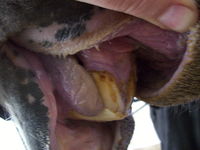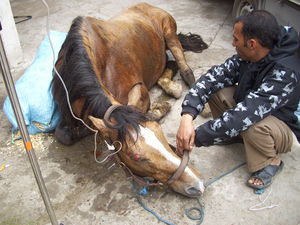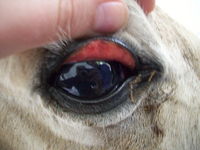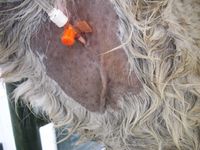Colic Diagnosis - General Physical Examination
| This article has been peer reviewed but is awaiting expert review. If you would like to help with this, please see more information about expert reviewing. |
General Physical Examination
A physical examination including the following parameters should be carried out immediately and thoroughly.
- Attitude and External appearance
- Abdominal contour (distention-unilateral vs. bilateral)
- Body Temperature
- Heart Rate and Pulse character, Respiratory rate and effort
- Skin Turgor, Mucous membrane color and moisture, Capillary refil time (CRT)
- Presence of digital pulses
For normal physiology values in horses, click here.
Attitude and External Appearance
It is important to assess the degree of pain. It is best do keep the patient in a quiet environment to fully assess them. If the owner or trainer of the horse has administered any treatments then the patients status may not be a true reflection of the clinical condition. If the horse is in severe, unrelenting pain and it is difficult to assess it safely, it is advisable to administer some analgesics, sedation and butyl-scopolamine prior to the examination. It is useful to get the heart rate prior to the administration of these medications due to their transient effects on the resting heart rate.
A horse with severe pain that is unresponsive to analgesics warrants going to surgery as soon as possible if it is a case of a strangulating obstruction. Multiple abrasions around the head and periorbital area indicate that the horse is experiencing severe pain. The duration of clinical signs is important to note as once the strangulated portion of intestine degenerates to a certain point, the pain will subside but the horse becomes increasingly depressed.
Non-infarctive conditions such as impactions and some ileal intussusceptions are demonstrated as intermittently, moderately painful cases.
A depressed horse that is pyrexic and displaying signs of moderate abdominal pain may indicate an inflammatory condition such as an enteritis, colitis of peritonitis.
The examination should also include the mouth for the presence of malocclusion, dental abnormalities, damage to the lips and gums, nasal discharge and excessive salivation. The abdominal contour should be examined for any swellings or recent enlargements which could indicate edema or umbilical, abdominal or scrotal herniations.
Abdominal Distension
Any degree of abdominal distension is usually indicative of a condition affecting the large intestines, as distension of the stomach and small intestine would not be large enough to be visible externally.
Body Temperature
Pyrexia may indicate an inflammatory or infectious condition and should be interpreted with other diagnostic tests such as fecal samples, hematology, biochemistry and blood cultures.
Cardiovascular Parameters
Tachypnoea and tachychardia can be seen in the horse with colic. This is due to pain, but mainly due to decreased circulating volume, decreased preload, and endotoxemia. The pulse can be palpated in the facial, digital, brachial and great metatarsal arteries. The heart rate should be measured over time, and its response to analgesic therapy ascertained. The pulse should be assessed at different sites. The blood pressure can be assessed with the use of a blood pressure cuff and Doppler around the coccygeal artery. The normal systolic pressure of a an adult horse should be 100 to 125 mm Hg. Horses with colic that have a systolic pressure of less than 80 mm Hg had a poorer prognosis. A pulse that continues to rise in rate to 60 to 70 beats per minute and weaken in quality over 6 to 8 hours in the face of adequate analgesia is considered a surgical indication. Infarctive disease is characterised by an increasing, non-fluctuating heart rate.
Mucous membrane colour and moisture and capillary refil time (CRT) can be assessed to appreciate the severity of haemodynamic compromise. The normal colour is pale pink and the CRT is 1 to 2 seconds. The gingival mucous membranes change from pink and moist to red and dry as the circulating blood volume decreases. The genital and conjunctival mucosa can also be assessed. Reddening of the mucous membranes indicates haemoconcentration and worsens as the patient goes into shock. Reddening reflects worse prognosis, and cyanotic membranes indicate a very poor chance of a positive outcome as it it indicates that the horse is in endotoxic shock. The CRT will be prolonged with dehydration and endotoxaemia.
The skin over the neck or eyelid can be tented to crudely assess the hydration status of the horse. The skin of a normally hydrated horse should return to its initail position almost immediately. A reduced skin tent indicates dehydration.
References
- Edwards B. (2009), Diagnosis and Pathophysiology of Intestinal Obstruction, in Equine Gastroenterology courtesy of the University of Liverpool, pp 7-9
- Meuller E, Moore J. N, (2008) Classification and Pathophysiology of Colic, Gastrointestinal Emergencies and Other Causes of Colic, in Equine Emergencies- Treatments and Procedures, 3rd Edition, Eds Orsini J. A, Divers T.J, Saunders Elsevier, pp 107-109
- Rose R.J, Hodgson D.R (2000) Examination of the Alimentary Tract, Alimentary Tract, Manual of Equine Practice, 2nd Edition, Saunders Elsevier, pp 293



